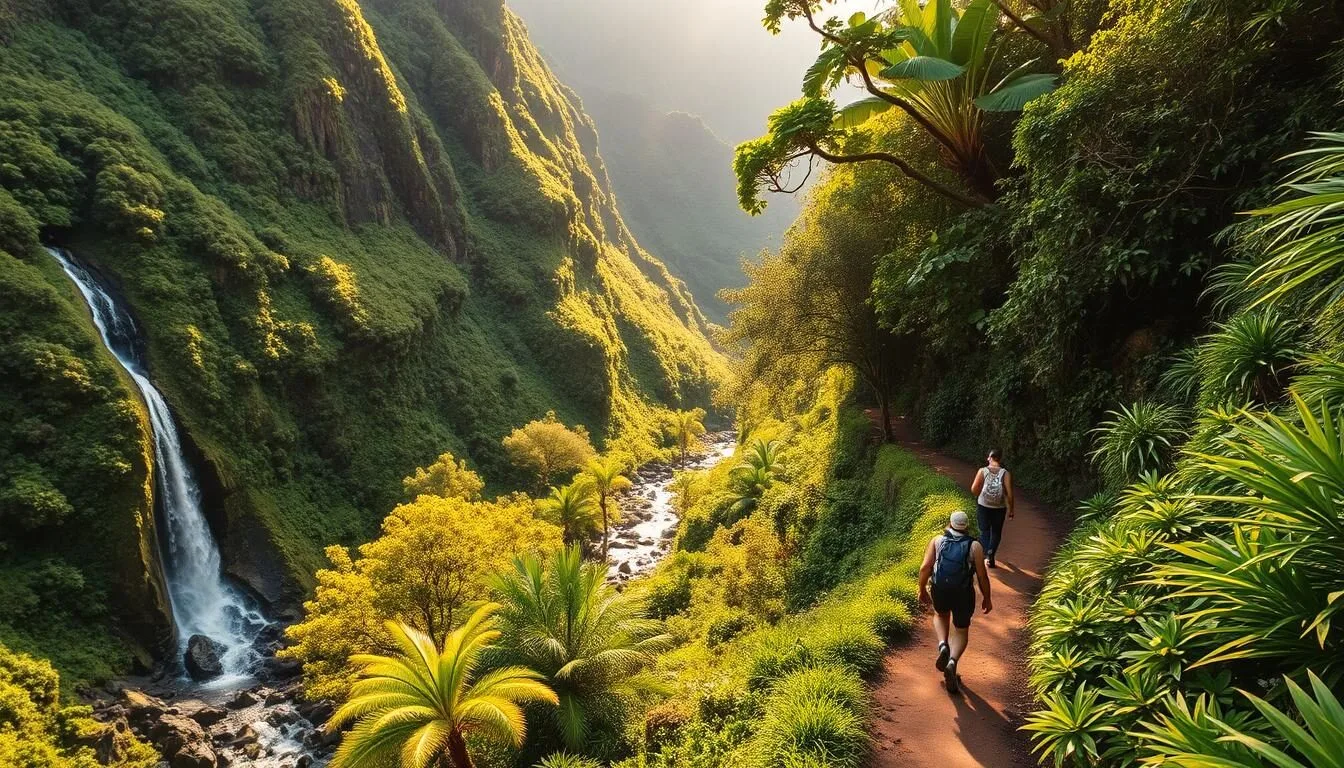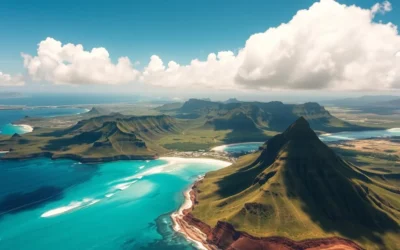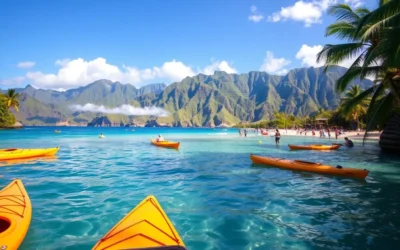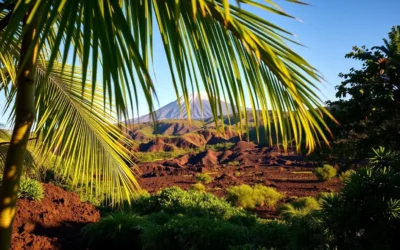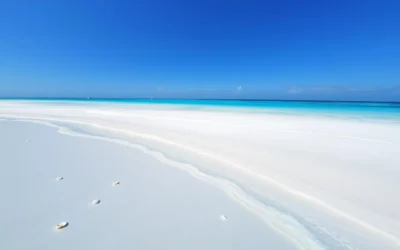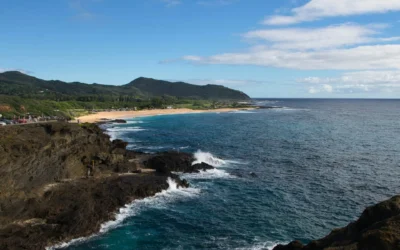✓ Accommodations ✓ Flights ✓ Rental Cars ✓ Tours & Activities
Imagine walking through a lush, tropical paradise, surrounded by ancient history and breathtaking natural beauty. You’re about to embark on an adventure of a lifetime in one of Hawaii’s most unique cultural sites.
As you hike through the valley, you’ll pass by ancient rock features, cross rivers, and finally arrive at a refreshing waterfall with a swimming pond. This guide will help you plan your visit and make the most of your experience.
You’ll be immersed in the history and culture of early Polynesian settlers, making for an unforgettable experience. Get ready to explore one of Hawaii’s best-kept secrets and create lifelong memories.
Discovering Hālawa Valley: An Ancient Hawaiian Treasure
As you step into Hālawa Valley, you’re walking in the footsteps of early Polynesian settlers who arrived around 650 AD. This valley is a treasure trove of history, culture, and natural beauty, making it a unique destination on the island of Molokai, Hawaii.
Geography and Natural Features
Hālawa Valley is characterized by its lush landscape and rich natural resources. The valley’s geography is marked by extensive taro terraces that utilize the natural water flow from the mountains to the sea, showcasing the ingenuity of ancient Hawaiian agricultural systems.
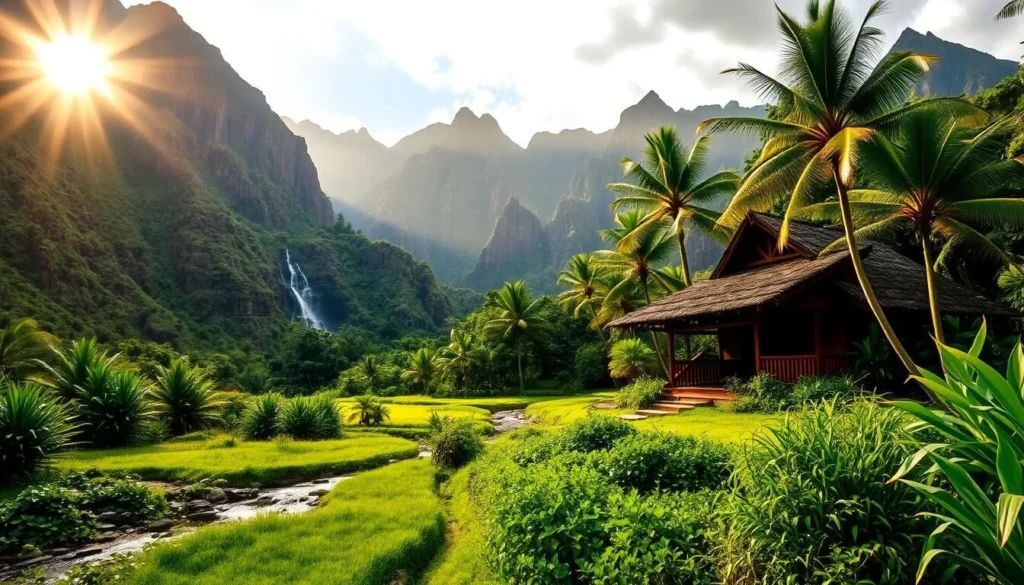
Historical and Cultural Significance
The historical and cultural significance of Hālawa Valley cannot be overstated. It is one of the earliest documented settlements in Hawaii, with a history that spans centuries. Visitors can observe remnants of ancient Hawaiian engineering, including stone walls, heiau (temples), and agricultural terraces. Local guides, such as those from the Solatorio family, share stories and traditions, providing a deeper understanding of the valley’s importance to Hawaiian identity and culture.
The valley’s cultural importance extends beyond its physical structures to include generations of oral traditions, chants, and practices. Despite being abandoned as a major settlement due to natural disasters and demographic changes, Hālawa Valley remains a paramount site for understanding Hawaiian history and the relationship between people and the land.
Planning Your Visit to Hālawa Valley, Molokai, Hawaii
Before you embark on your journey to Hālawa Valley, it’s crucial to plan your visit. This ensures that your trip is both enjoyable and safe.
Best Times to Visit
The best time to visit Hālawa Valley is during the dry season, which typically runs from May to October. During this period, the weather is more favorable for hiking and exploring the valley. You need to get familiar with the local weather forecast before heading out.
Getting to Hālawa Valley
To get to Hālawa Valley, you’ll first need to arrive on the island of Molokai. You can fly into Molokai Airport or take a ferry from other Hawaiian islands. From there, you can rent a car or hire a guided tour to take you to the valley. Make sure you have a reliable means of transportation, as public options are limited.
Essential Items to Pack
Packing the right gear is vital for a comfortable and safe hike to Mo’oula Falls. You should bring sturdy, water-friendly hiking shoes, a swimsuit, a light rain jacket, water, and snacks. Don’t forget sun protection and insect repellent. It’s also a good idea to bring a waterproof bag to protect your electronics.
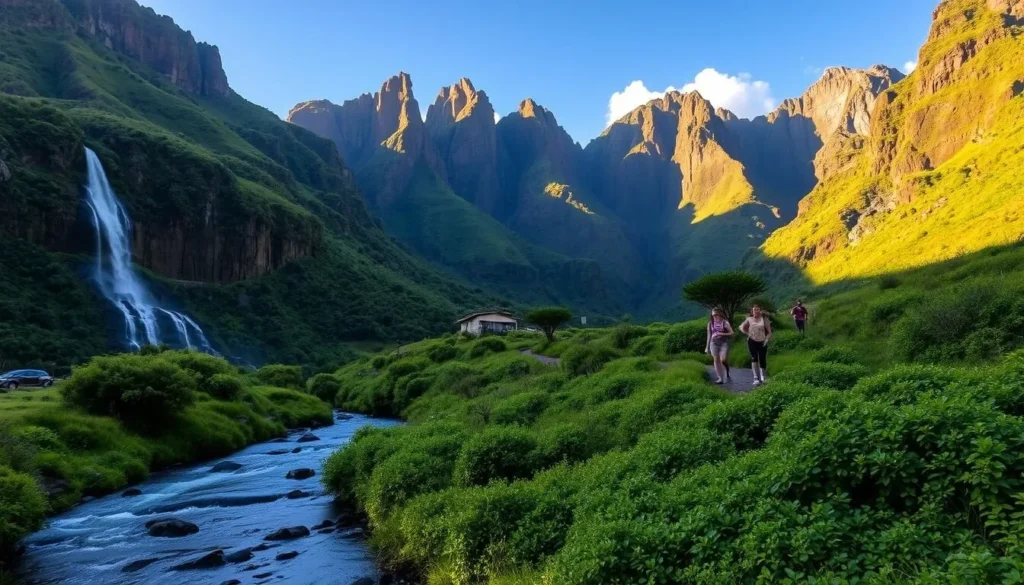
Guided Tours: The Only Way to Experience Mo’oula Falls
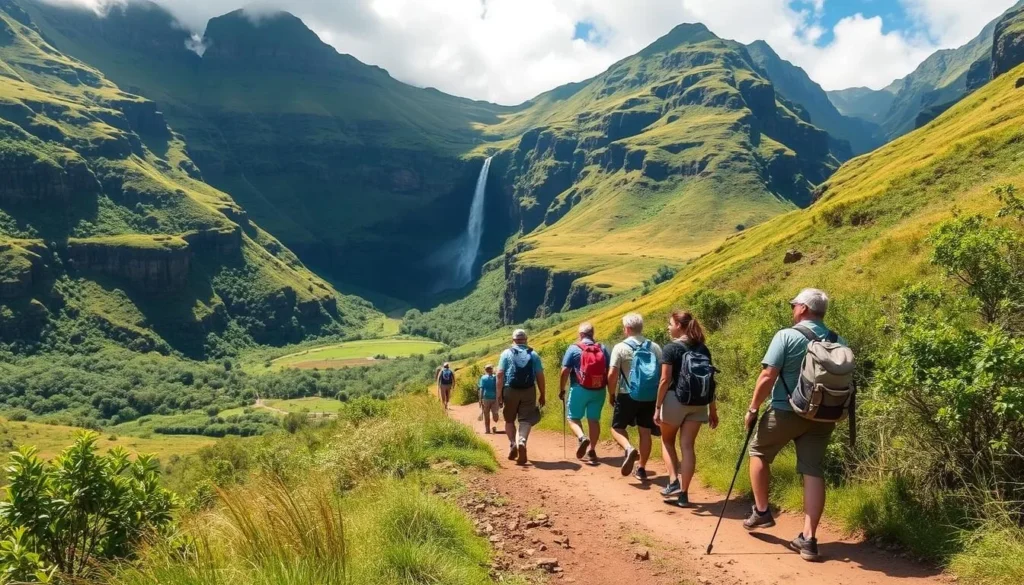
A guided tour is the only way to truly immerse yourself in the natural and cultural wonders of Hālawa Valley. The Solatorio family offers an authentic experience, sharing their knowledge of the land, history, and traditions.
The Solatorio Family Experience
The Solatorio family’s guided tours provide a unique and enriching experience. With their in-depth knowledge of Hālawa Valley’s history, culture, and natural environment, they offer a comprehensive understanding of this sacred place. As you hike through the valley, your guide will point out significant features, share stories, and demonstrate traditional practices.
What to Expect on a Guided Tour
Guided tours typically last 3-4 hours, including a cultural orientation and approximately 2 hours of hiking. You’ll traverse river crossings, dense vegetation, and ancient structures, gaining insight into native plants, their uses, and the history of archaeological sites. The tour culminates at Mo’oula Falls, where you can swim and enjoy lunch before returning along the same trail.
- Explore the valley’s significant cultural sites, including heiau (temples) and agricultural terraces.
- Learn about native plants and their traditional uses.
- Swim in the pool beneath the 250-foot Mo’oula Falls.
- Enjoy a relaxing lunch amidst the natural beauty of the valley.
The Hālawa Valley Falls Trail
Walking through the Hālawa Valley Falls Trail is like stepping into a living museum, where every step reveals a piece of Hawaiian heritage. As you journey through this lush valley, you’ll encounter remnants of ancient Hawaiian engineering, including temples, agricultural terraces, and boundary markers.
Trail Difficulty and Length
The Hālawa Valley Falls Trail is a moderately difficult hike, stretching approximately 4 miles round trip. The trail takes you through a lush, tropical landscape, with the sound of the river accompanying you along the path. The terrain can be rugged, with some steep inclines, but the scenery makes the effort worthwhile.
| Trail Feature | Description |
|---|---|
| Distance | 4 miles round trip |
| Difficulty | Moderate |
| Terrain | Rugged with steep inclines |
River Crossings and Safety Tips
One of the exciting aspects of hiking the Hālawa Valley Falls Trail is the river crossings. You’ll need to wade through the river at several points along the trail. It’s essential to be cautious, especially during periods of heavy rainfall when the river can swell. Always check the current conditions before attempting a crossing, and consider using trekking poles for added stability.
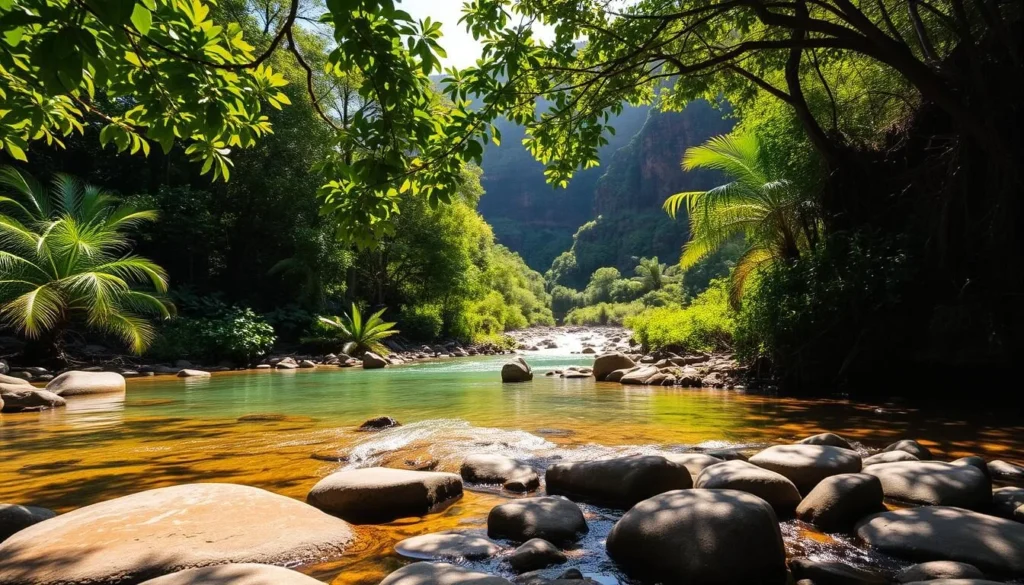
As you make your way along the path, you’ll notice large piles of rocks that are believed to be the remains of ancient Hawaiian Heiaus (temples). These structures are a testament to the spiritual and cultural significance of the area.
Ancient Sites Along the Path
The Hālawa Valley is dotted with ancient sites, including temples and farming terraces. As you walk through the valley, your guide will point out these archaeological features, explaining their historical significance and the role they played in ancient Hawaiian society. You’ll visit places where early Hawaiians lived and worked, gaining a deeper understanding of their connection to the land. Be sure to respect these sites, as they are protected cultural resources, and take a moment to appreciate the history that surrounds you at every spot.
Mo’oula Falls: The Valley’s Crown Jewel
Mo’oula Falls, a breathtaking 250-foot waterfall, is the crown jewel of Hālawa Valley, Molokai. This natural wonder is a highlight of any visit to the valley, offering opportunities for swimming and capturing stunning photographs.
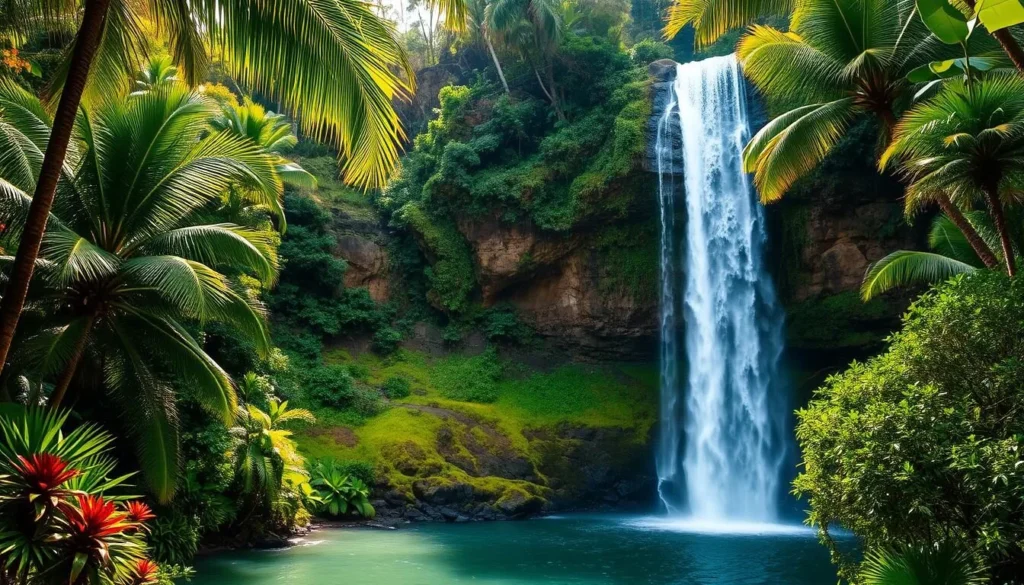
Swimming at the Waterfall
Swimming at Mo’oula Falls is an exhilarating experience. The waterfall creates a natural pool that’s perfect for a refreshing swim. As you enjoy the cool waters, take a moment to appreciate the surrounding lush vegetation and the roar of the falls in the background. To make the most of your visit, be sure to follow safety guidelines and respect the natural environment.
| Safety Tips | Precautions |
|---|---|
| Check the water level before swimming | Avoid swimming during heavy rainfall |
| Be mindful of slippery rocks | Watch for strong currents |
Photography Opportunities
Mo’oula Falls offers numerous photography opportunities, particularly in the morning when the sunlight illuminates the cascade without harsh shadows. To take pictures that truly capture the essence of the falls, position yourself on the large rocks at the edge of the swimming pool. These natural vantage points provide stable platforms for tripods and unobstructed views of both tiers of the waterfall. Don’t forget to include natural framing elements like overhanging branches or colorful tropical flowers in the foreground to add depth to your photographs.
- Use a waterproof case or microfiber cloth to protect your camera equipment from the mist.
- Capture the journey to the falls, including river crossings and lush valley views.
- Experiment with different angles and compositions to find your perfect spot.
Cultural Protocols and Respectful Visitation
Visiting Hālawa Valley is not just about enjoying its natural beauty, but also about respecting its cultural heritage. As you explore this ancient Hawaiian treasure, understanding and adhering to cultural protocols is crucial.
Hawaiian Traditions in Hālawa Valley
Hālawa Valley is steeped in Hawaiian traditions and history. To respectfully visit, you should join a guided tour led by families with deep ties to the valley. This not only supports local families but also enriches your experience with cultural context. When hiking in Hālawa Valley, stay on marked paths to protect ancient sites and fragile plants.
- Stay on marked trails to avoid damaging the environment and cultural sites.
- Wear sturdy shoes to ensure your safety and prevent trail damage.
Responsible Tourism Practices
Practicing responsible tourism is vital in preserving Hālawa Valley’s beauty and cultural significance. When swimming at the waterfalls, avoid using soaps or lotions that could contaminate the water. Instead, apply reef-safe, biodegradable products before reaching the falls. Additionally, leave no trace by packing out all trash and refraining from removing natural items as souvenirs.
- Pack out all trash, including food wrappers and empty bottles, to keep the valley clean.
- Speak quietly and behave respectfully, especially near cultural sites, to honor the valley’s spiritual importance.
- Support sustainable tourism by paying fair prices for guided experiences and tipping guides appropriately.

By following these guidelines, you contribute to the preservation of Hālawa Valley’s unique cultural and natural heritage, ensuring that it remains a treasure for generations to come.
Conclusion: Preserving the Magic of Hālawa Valley
Hālawa Valley offers an unforgettable blend of adventure, cultural insight, and natural splendor that stays with you long after you’ve left. As you plan your visit, remember that the experience is not just about the scenic views or the hike to Mo’oula Falls; it’s about immersing yourself in a living cultural heritage.
The Halawa Valley Falls Cultural Hike is a journey through time, where every step reveals a piece of history, a native plant, or a story of the earliest Polynesian settlers. By supporting local families like the Solatorios through guided hikes, you’re contributing to the preservation of this sacred place.
To make the most of your visit, prepare appropriately for river crossings and variable weather, and approach the valley with a respectful attitude. The memories you create—swimming beneath Mo’oula Falls, learning about native plants along the path, and crossing rivers surrounded by ancient history—will be among your favorite moments from your time in Hawaii.
By being a mindful visitor, you help preserve the magic of Hālawa Valley for future generations. As you head back, the valley’s serene beauty and rich cultural heritage will linger, leaving you with a deeper appreciation for Hawaii beyond the typical tourist experience.
The above is subject to change.
Check back often to TRAVEL.COM for the latest travel tips and deals.
